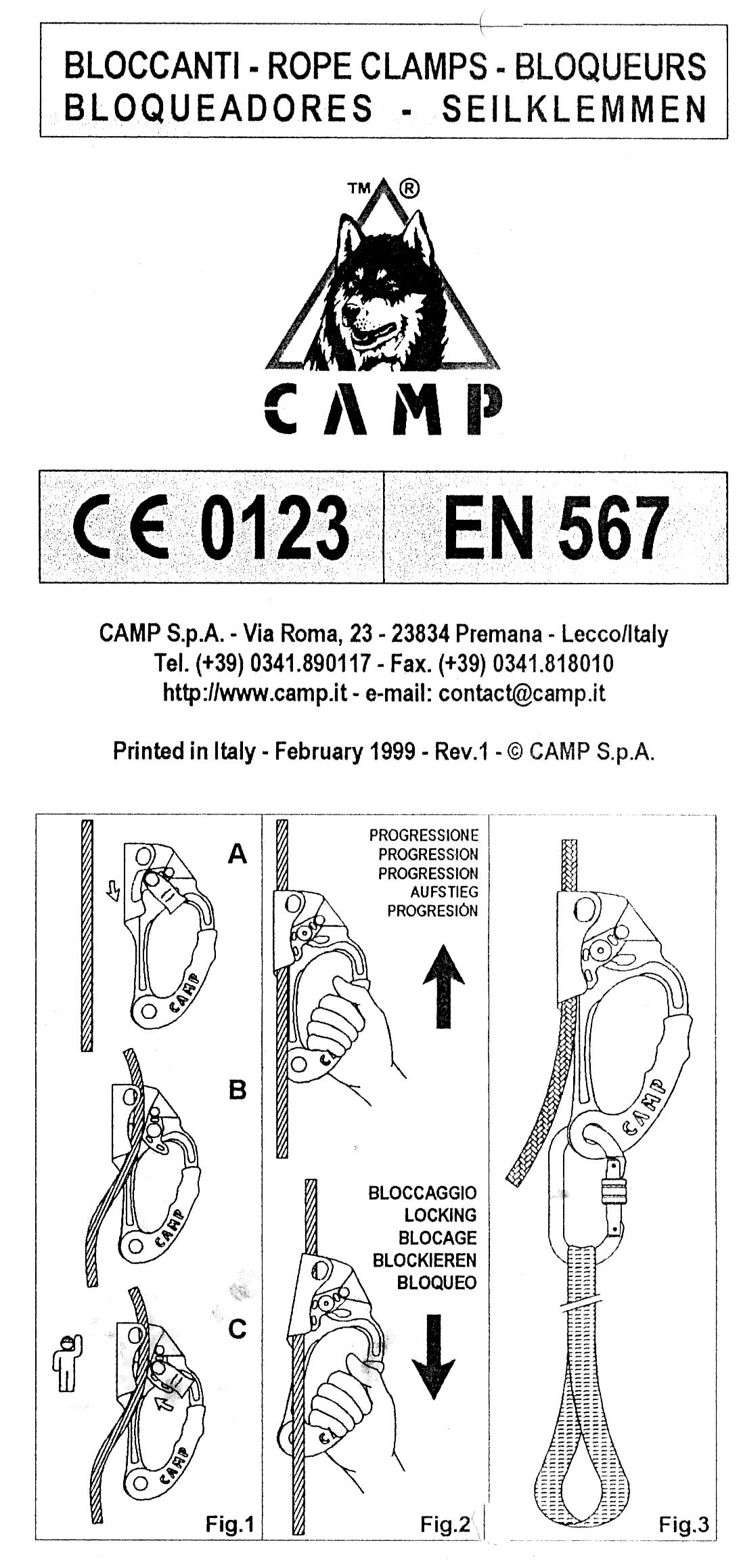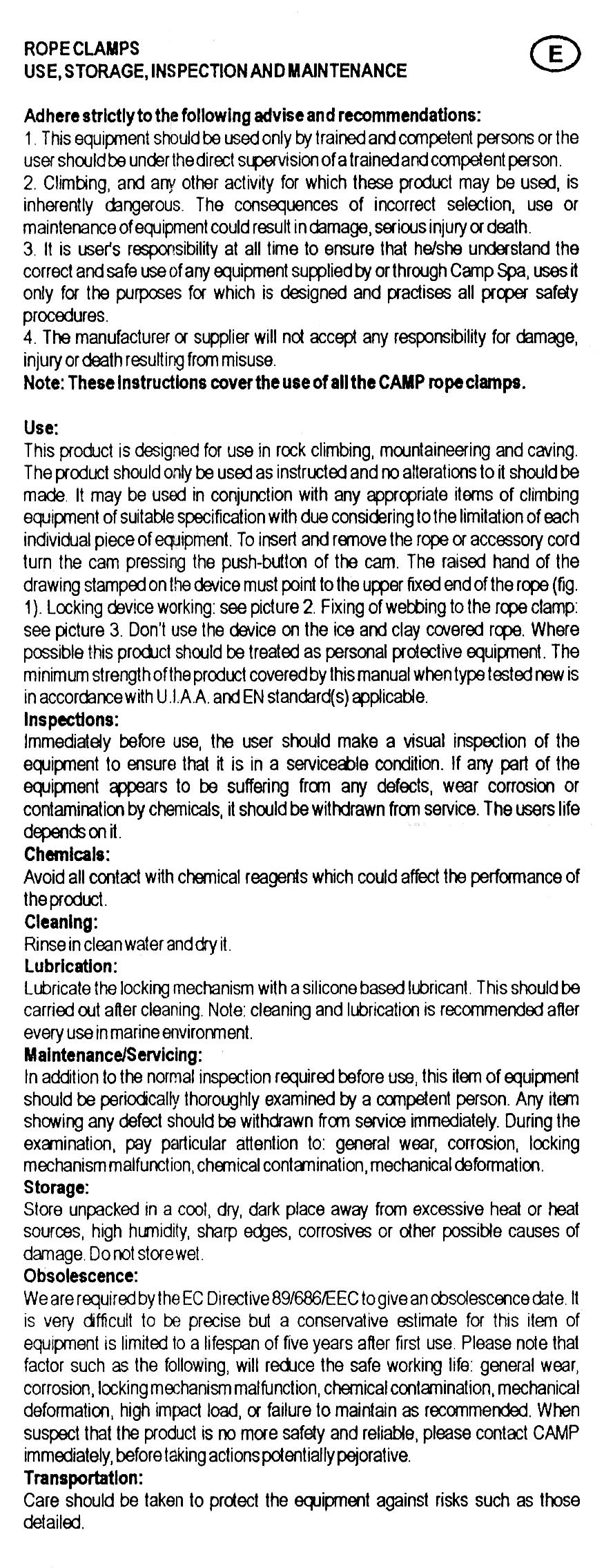Overview
History
Blacksmith Nicola Codega founded C.A.M.P. in 1889 to produce wrought-iron goods. The company first entered the climbing equipment business in 1920 when Nicola's son Antonio started making ice axes for the Italian Army Alpine Corps. The firm continued to grow and was handed down through the family.
From about 1950 through 1976, C.A.M.P. used a diamond-shaped logo bearing "D CN & FD CAMP" for "Ditta Codega Nicola & Figli De Codega Antonio Metilde Premana."
In 1968, C.A.M.P. entrusted Robert Charles Maillot and his firm Interalp to distribute C.A.M.P. products outside Italy. These products bore both C.A.M.P. and INTERALP logos. Their relationship continued until 1980.
C.A.M.P. changed its name to "Construzione Articoli Montagna Premana" in 1972.
In 1972 C.A.M.P. started using a new logo with "CAMP" inside a rounded rectangle above a mountain. The transition was completed around 1976.
C.A.M.P. introduced a new wolfs-head logo in 1992.
C.A.M.P. acquired Cassin in 1997.
In 2003 C.A.M.P. again changed the company name, this time to "Concezione Articoli Montagna Premana" and changed their logo to CAMP in italics.
C.A.M.P. introduced another new logo in 2022 and returned to the name "Construzione Articoli Montagna Premana."

Many C.A.M.P. products from recent decades have a product traceability code that indicates when they were made. Denis Pivot sent me the following "secret decoder ring" for interpreting these codes:
- Until and including 1995: The code is three or four digits. The first one or two indicate the batch number and the remaining two indicate the year.
- For example, "295" means second batch made in 1995.
- From 1996 through 2005, The code is a numeral indicating the batch nmuber and a letter in the Italian alphabet indicating the year, with A in 1996 through I in 2004 and L in 2005 (J and K do not exist) .
- For example, "1D" means the first batch made in 1999.
- From 2006 unttil 2016: The code is three digits. the first indicates the batch number and the remaining two indicate the year.
- For example, "216" means second batch made in 2016.
- From 2017 onward: The code is two two-digit numbers, where the first indicates the month and the second pair indicates the year.
- For example, "05 17" means it was made in May 2017.
Some products may not have received a product traceability code.
[ Top
| Pilot, v. B
| Pilot, v. C
| Turbohand
| Turbohand Pro
| Return to H.E.C. Ascenders
]
Pilot, Version A
(#151, 2206)
Technical Details
I acquired this pair of ascenders from K&R Adventure Gear
in March 2001. They were from the first batch made in 2000. I acquired another pair in 2017 as part of Bob Thrun’s collection.
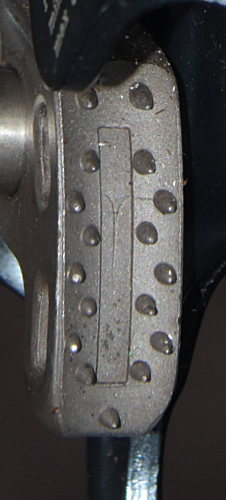 The shell is a tall irregular shaped stamping made from 3.5 mm. aluminum alloy sheet metal. The stamping has a number of reinforcing
ribs. A rope channel is formed in the upper portion of one side
and a smaller cam channel lies opposite the first. A hole drilled
through both sides of the cam channel accepts a 4 mm. pin
which enters from the rear and is expanded in front. The cam,
cam spring and a spacing washer are mounted on this pin. The handle
below the cam has a "rubber" plastic hand grip molded
into place. The hand grip has shallow index and ring finger grooves.
A 15.8 mm. sling attachment hole is punched below the handle
opening. A 14.6 by 18.3 mm. oval hole through both sides
of the rope channel provides an attachment point just above the
cam. An arc-shaped slot is punched below and concentric with the
cam pivot. This slot is enlarged at both ends and narrow in the
center. The cam safety rides in this slot.
The shell is a tall irregular shaped stamping made from 3.5 mm. aluminum alloy sheet metal. The stamping has a number of reinforcing
ribs. A rope channel is formed in the upper portion of one side
and a smaller cam channel lies opposite the first. A hole drilled
through both sides of the cam channel accepts a 4 mm. pin
which enters from the rear and is expanded in front. The cam,
cam spring and a spacing washer are mounted on this pin. The handle
below the cam has a "rubber" plastic hand grip molded
into place. The hand grip has shallow index and ring finger grooves.
A 15.8 mm. sling attachment hole is punched below the handle
opening. A 14.6 by 18.3 mm. oval hole through both sides
of the rope channel provides an attachment point just above the
cam. An arc-shaped slot is punched below and concentric with the
cam pivot. This slot is enlarged at both ends and narrow in the
center. The cam safety rides in this slot.
The cam is a steel casting. The cam has seventeen
small conical teeth, all of which have their axes approximately
parallel to each other. The central teeth have their axes in line
with the cam pivot. The tooth pattern is (2)(1D1)^7(1) where D
is a shallow depression that does not penetrate the cam face. Unlike
some other ascenders, the inner cam face radius appears to be
constant. A spring-loaded manual safety passes through the cam
and the arc-shaped slot in the shell. The head of the safety forms
a 15 mm. diameter round-headed button. The safety shaft is
6 mm. in diameter, then increases to 8.5 mm. where it
passes through the shell, and finally to 11 mm. Normally
a spring pushes the safety toward the front of the ascender, and
the enlarged 8.5 mm. portion fits into one of the large areas
of the slot. Depending on which end of the slot it is in, this
either keeps the cam from opening enough to release the main rope
or keeps the cam from closing. Pushing the head of the safety
aligns the 6 mm. shaft with the shell, allowing the cam to
move through it’s full range of motion.
The right ascender is anodized blue and the left one gray.
The front has the C.A.M.P. logo, the "Sieg Heil" icon, "EN 567,"
"CE0123," "ROPE," "min ø 8"
and "max ø 13" printed onto the rope channel.
The left ascender has "Italy" and "1E" printed
on the cam channel, the right one has "Italy" and "4D"
in the corresponding place. "CAMP" is molded into the
front and back of each handgrip.
The Pilot is the handled version of the C.A.M.P.
Solo.
The Camp Pilot is one of the following handled ascenders sharing the same cam safety design (which is also found on the Camp
Solo):
These are well made ascenders. All sharp
edges have been removed. Admittedly, we don't have as much experience with Chinese metallurgy and quality control as we have with American and European devices, but I find nothing visibly wrong with these ascenders.Umfortunately, each of the Chinese versions (Blanzo, Magideal and SUT) have fraudulent CE marks.
All of these have comfortable handles. The location of the index finger supports on the Magideal and SUT are fine for my large hands.
I like the location of the reinforcing better on these than the location used on, say, the Kong-Bonaiti or Petzl
Ascension. Accidental bending at the pit lip is still a concern, but the reinforcing helps.
The lower attachment
hole could theoretically have the same safety problems as the
one on Clog Version A. The attachment points are simply holes
in the shell, but on the Blanzo and the C.A.M.P Pilot
, the "rubber" handgrip encircles the
holes. This provides some rounding but since the metal edges do
not appear to be beveled, I would prefer not to tie directly into
them. Considering the proximity of the attachment points to the
main rope, I would recommend using a small maillon for most attachments
in order to reduce the risk of sling abrasion.
The Magideal and SUT also have outer lower attachment holes, but these are too small for a normal carabiner. I'm not sure the extra holes are needed at the base. Except for the Petzl Pompe, I've never found a real need for a second hole. Some people like them, and I might find them more appealing if they were large enough for a standard carabiner to fit through.
The upper
attachment holes are located very close to the main rope. A
carabiner through the upper attachment hole will probably drag
on the main line. Note that such a carabiner will prevent putting
the ascender on or off rope, so one's climbing system must be
designed accordingly.
These ascenders use several different cams, but in each case the cam is very well made and the cam teeth are very well done. The Magideal and SUT cams are essentially identical. The Blanzo and C.A.M.P Pilot, Versions B & C have the same tooth pattern, but the rows on the Blanzo are in four groups (4, 2, 2, and 3 rows per group) while aside from an isolated top tooth, all of the rows on the Version B & C Pilots are evenly spaced.
When I first encountered the design on the Camp Pilot, I found the safety took a
few minutes to get used to. After minimal practice I decided
that this is one of the easier safety designs to operate for stamped-frame handled eccentric cam ascenders. Single-handed operation of thse ascenders is fairly
easy with the either hand. Closing an locked open ascender is
accomplished with a simple push on the button.
Overall, I like these ascenders better than most stamped-frame handled ascenders. The price of the Chinese ascenders was much lower than the C.A.M.P Pilot
's.
[ Top
| Pilot, v. A
| Pilot, v. C
| Turbohand
| Turbohand Pro
| Return to H.E.C. Ascenders
]
Pilot, Version B
(#2206)
Technical Details
I acquired my C.A.M.P. Pilot, Version B in 2017 as part of Bob Thrun’s collection. The were made in 2005.
Version B is 200 mm. tall, 99 mm. wide, 32 mm. thick, and weighs 209 g.
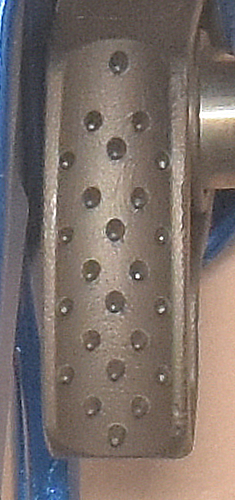 The shell on Version B is essentially the same as the one on Version A (except for stampings), but the cam is new.
The shell on Version B is essentially the same as the one on Version A (except for stampings), but the cam is new.
The cam is a skeletonized steel casting. The cam has twenty-four
small conical teeth, all of which have their axes approximately
parallel to the cam top. The central teeth have their axes in line
with the cam pivot. The tooth pattern is (1)(2.3)^4(2.1). Unlike
some other ascenders, the inner cam face radius appears to be
constant. A spring-loaded manual safety passes through the cam
and the arc-shaped slot in the shell. The head of the safety forms
a 15 mm. diameter round-headed button. The safety shaft is
11.8 mm. in diameter, then narrows to 4 mm. inside the cam, then increases to 7.5 mm. where it
passes through the shell, and finally to 11 mm. Normally
a spring pushes the safety toward the front of the ascender, and
the enlarged 7.5 mm. portion fits into one of the large areas
of the slot. Depending on which end of the slot it is in, this
either keeps the cam from opening enough to release the main rope
or keeps the cam from closing. Pushing the head of the safety
aligns the 4 mm. shaft with the shell, allowing the cam to
move through it’s full range of motion.
The front inside of the shell has"CE" and "0123" stamped above the cam, a reading-is-dangerous icon stamped below, and "EN 567," below the cam channel. The front of the rope channel is stamped with "ROPE MIN Ø8 MAX Ø13," "CAMP", and the "Sieg Heil" icon. The rear is stamped with "ITALY and "1-L" on the left-hand ascender and "2-05" on the right.
The Camp Pilot is one of the following handled ascenders sharing the same cam safety design (which is also found on the Camp
Solo):
These are well made ascenders. All sharp
edges have been removed. Admittedly, we don't have as much experience with Chinese metallurgy and quality control as we have with American and European devices, but I find nothing visibly wrong with these ascenders.Umfortunately, each of the Chinese versions (Blanzo, Magideal and SUT) have fraudulent CE marks.
All of these have comfortable handles. The location of the index finger supports on the Magideal and SUT are fine for my large hands.
I like the location of the reinforcing better on these than the location used on, say, the Kong-Bonaiti or Petzl
Ascension. Accidental bending at the pit lip is still a concern, but the reinforcing helps.
The lower attachment
hole could theoretically have the same safety problems as the
one on Clog Version A. The attachment points are simply holes
in the shell, but on the Blanzo and the C.A.M.P Pilot
, the "rubber" handgrip encircles the
holes. This provides some rounding but since the metal edges do
not appear to be beveled, I would prefer not to tie directly into
them. Considering the proximity of the attachment points to the
main rope, I would recommend using a small maillon for most attachments
in order to reduce the risk of sling abrasion.
The Magideal and SUT also have outer lower attachment holes, but these are too small for a normal carabiner. I'm not sure the extra holes are needed at the base. Except for the Petzl Pompe, I've never found a real need for a second hole. Some people like them, and I might find them more appealing if they were large enough for a standard carabiner to fit through.
The upper
attachment holes are located very close to the main rope. A
carabiner through the upper attachment hole will probably drag
on the main line. Note that such a carabiner will prevent putting
the ascender on or off rope, so one's climbing system must be
designed accordingly.
These ascenders use several different cams, but in each case the cam is very well made and the cam teeth are very well done. The Magideal and SUT cams are essentially identical. The Blanzo and C.A.M.P Pilot, Versions B & C have the same tooth pattern, but the rows on the Blanzo are in four groups (4, 2, 2, and 3 rows per group) while aside from an isolated top tooth, all of the rows on the Version B & C Pilots are evenly spaced.
When I first encountered the design on the Camp Pilot, I found the safety took a
few minutes to get used to. After minimal practice I decided
that this is one of the easier safety designs to operate for stamped-frame handled eccentric cam ascenders. Single-handed operation of thse ascenders is fairly
easy with the either hand. Closing an locked open ascender is
accomplished with a simple push on the button.
Overall, I like these ascenders better than most stamped-frame handled ascenders. The price of the Chinese ascenders was much lower than the C.A.M.P Pilot
's.
[ Top
| Pilot, v. A
| Pilot, v. B
| Turbohand
| Turbohand Pro
| Return to H.E.C. Ascenders
]
Pilot, Version B
(#3452)
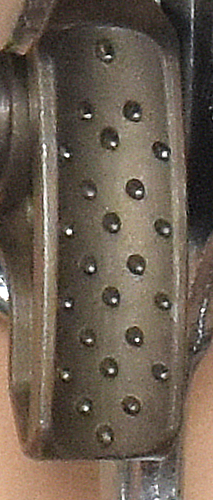 Technical Details
Technical Details
I acquired my C.A.M.P. Pilot, Version C from Curt T. Fladager in 2021. It was made in April, 2014
Version C is 200 mm. tall, 100 mm. wide, 32 mm. thick, and weighs 216 g.
Version C is essentially the same as Version N, except for stampings.
The front inside of the shell has"CE" and "0123" stamped above the cam and a reading-is-dangerous icon stamped below. The front of the rope channel is printed with the C.A.M.P. Safety logo, "Made in ITALY," "PILOT,’ "Ref.547.01," "EN 567:1997," 8≤ø≤13, the "Sieg Heil" icon, "3 11, and "0414." "CAMP" is molded into the
front and back of each handgrip.
The Camp Pilot is one of the following handled ascenders sharing the same cam safety design (which is also found on the Camp
Solo):
These are well made ascenders. All sharp
edges have been removed. Admittedly, we don't have as much experience with Chinese metallurgy and quality control as we have with American and European devices, but I find nothing visibly wrong with these ascenders.Umfortunately, each of the Chinese versions (Blanzo, Magideal and SUT) have fraudulent CE marks.
All of these have comfortable handles. The location of the index finger supports on the Magideal and SUT are fine for my large hands.
I like the location of the reinforcing better on these than the location used on, say, the Kong-Bonaiti or Petzl
Ascension. Accidental bending at the pit lip is still a concern, but the reinforcing helps.
The lower attachment
hole could theoretically have the same safety problems as the
one on Clog Version A. The attachment points are simply holes
in the shell, but on the Blanzo and the C.A.M.P Pilot
, the "rubber" handgrip encircles the
holes. This provides some rounding but since the metal edges do
not appear to be beveled, I would prefer not to tie directly into
them. Considering the proximity of the attachment points to the
main rope, I would recommend using a small maillon for most attachments
in order to reduce the risk of sling abrasion.
The Magideal and SUT also have outer lower attachment holes, but these are too small for a normal carabiner. I'm not sure the extra holes are needed at the base. Except for the Petzl Pompe, I've never found a real need for a second hole. Some people like them, and I might find them more appealing if they were large enough for a standard carabiner to fit through.
The upper
attachment holes are located very close to the main rope. A
carabiner through the upper attachment hole will probably drag
on the main line. Note that such a carabiner will prevent putting
the ascender on or off rope, so one's climbing system must be
designed accordingly.
These ascenders use several different cams, but in each case the cam is very well made and the cam teeth are very well done. The Magideal and SUT cams are essentially identical. The Blanzo and C.A.M.P Pilot, Versions B & C have the same tooth pattern, but the rows on the Blanzo are in four groups (4, 2, 2, and 3 rows per group) while aside from an isolated top tooth, all of the rows on the Version B & C Pilots are evenly spaced.
When I first encountered the design on the Camp Pilot, I found the safety took a
few minutes to get used to. After minimal practice I decided
that this is one of the easier safety designs to operate for stamped-frame handled eccentric cam ascenders. Single-handed operation of thse ascenders is fairly
easy with the either hand. Closing an locked open ascender is
accomplished with a simple push on the button.
Overall, I like these ascenders better than most stamped-frame handled ascenders. The price of the Chinese ascenders was much lower than the C.A.M.P Pilot
's.
[ Top
| Pilot, v. A
| Pilot, v. B
| Pilot, v. C
| Turbohand Pro
| Return to H.E.C. Ascenders
]
Turbohand
(#2386/2943)
Technical Details
I acquired my C.A.M.P. Turbohands from Rock N Rescue in 2019. They were made in April of that year.
The C.A.M.P. Turbohand is 185 mm.
tall, 94 mm.
wide, 22 mm.
thick, and weighs 172 g.
The shell is a tall rounded stamping made from 3.4 mm. aluminum alloy sheet metal. A rope channel is formed in the upper portion of one side. The rope channel is 14 mm.
wide. A small extension at the base of the rope channel supports a pin that acts as an axle for a small roller.
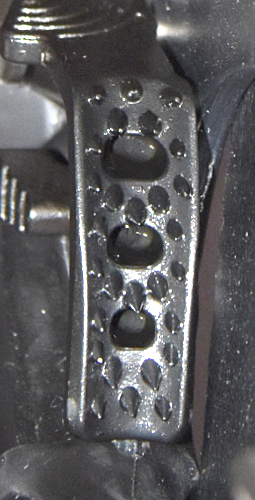 A hole drilled through
the shell supports a 6 mm. pin which enters
from the front and is riveted over a bushing in the rear. The cam, cam spring and
a spacing washer are mounted on this pin. A small pin riveted below the cam axle acts as a cam stop.
A hole drilled through
the shell supports a 6 mm. pin which enters
from the front and is riveted over a bushing in the rear. The cam, cam spring and
a spacing washer are mounted on this pin. A small pin riveted below the cam axle acts as a cam stop.
The shell has dogleg bends that offset the handle toward the front of the ascender. The handle
below the cam has a "rubber" plastic hand grip molded
into place. The hand grip extends up the side of the ascender. It has a shallow index finger support.
A 15.7 mm. sling attachment hole is punched below the handle
opening and a 13.2 mm. hole is punched beside it. There is also a 15 mm. attachment hole above the cam.
The cam is a skeletonized steel casting. The cam radius increases from 29 to 50 mm. over an angle of 38°, giving a 40° cam angle. The tooth pattern is (3.2)(1H1)(2.2.3.H.2.2.1)(1H1)(2.2.3). A spring-loaded manual safety mounts on the bottom inside of the cam.
The front has the C.A.M.P. Safety Logo, "TURBO HAND," and "L" ("R" on the right hand ascender) printed onto the rope channel. The rear is printed with "04 19," "AC 0154," the C.A.M.P. Safety Logo,"REF.2643L," a book-with-an-"i" icon, "CE," "0123," "EAC," "TP TC," "019/2011," "Camp SPA," "Via Roma 23," "Primana (LG)," "23834 - Italy," "Made in China, "EN567:2013¡¤8<ø<13," another book-with-an-"i" icon,"EN12841B:2006•10<ø<13," yet another book-with-an-"i" icon, and "Max. 120 kg."
The Turbohand is the handled ascender designed to accompany the the Solo 2 and Turbochest. I feel that this is a well made ascender. All sharp
edges have been removed. The attachment points are simply holes
in the shell, and I prefer not to tie directly into
them. Considering the proximity of the attachment points to the
main rope, I would recommend using a small maillon for most attachments
in order to reduce the risk of sling abrasion. The lower attachment
hole could theoretically have the same safety problems as the
one on Clog.
The cam teeth are very well done. I found the safety took a
few minutes to get used to, but after some practice I found that single-handed operation of this ascender is fairly
easy with the either hand. Closing an locked open ascender is
accomplished with a simple push on the cam.
This ascender has the same pit lip disadvantage as the Clog.
Unlike most ascenders, this one does not have the shell bent to form a channel to support the outer end of the cam axle. I have some concern about the bending moment placed on the axle, and wonder if, over time, the axle might loosen.
[ Top
| Pilot, v. A
| Pilot, v. B
| Pilot, v. C
| Turbohand
| Return to H.E.C. Ascenders
]
Turbohand Pro
(#2944)
 Technical Details
Technical Details
I acquired my C.A.M.P. Turbohand Pro from Omni Pro Gear in 2019.
The C.A.M.P. Turbohand Pro is 185 mm. tall, 94 mm. wide, 22 mm. thick, and weighs 185 g.
The Turbohand Pro adds a forged stainless steel guide to the Turbohand. The guide is attached to the lower frame with two 2.5 mm. hex socket machine screws. This guide forms a U-shaped rope channel near the basal attachment eye.
The markings on the Turbohand Pro are the same as on the corresponding Turbohand ascender.
The guide adds 13 g to the weight of each ascender. While this is not much, I don't see any need for the guide, so I would rather do without it.
[ Top
| Pilot, v. A
| Pilot, v. B
| Pilot, v. C
| Turbohand
| Turbohand Pro
]




